|
The
span of our modest lifetimes is insufficient to comprehend the present
state of relative stability that we perceive as normal. But that is far
from accurate if we were to multiply our time on earth by 100, we'd more
appreciate the ever changing conditions, that we believe is cast is stone.
The origin of Earth's oceans is unknown. Oceans are thought to have formed in the Hadean eon and may have been the cause for the emergence of life.
Plate tectonics, post-glacial rebound, and sea level rise continually change the coastline and structure of the world ocean. A global ocean has existed in one form or another on Earth for eons.
Since its formation the ocean has taken many conditions and shapes
(including smaller subdivisions as seas) with many past ocean divisions and potentially at times covering the whole globe.
During colder climatic periods, more ice caps and glaciers form, and enough of the global water supply accumulates as ice to lessen the amounts in other parts of the water cycle. The reverse is true during warm periods. During the last ice age, glaciers covered almost one-third of Earth's land mass with the result being that the oceans were about 122 m (400 ft) lower than today. During the last global "warm spell," about 125,000 years ago, the seas were about 5.5 m (18 ft) higher than they are now. About three million years ago the oceans could have been up to 50 m (165 ft) higher.
Rivers
are important for returning evaporated water that falls as rain on land,
back to the ocean. In a continuous cycle.
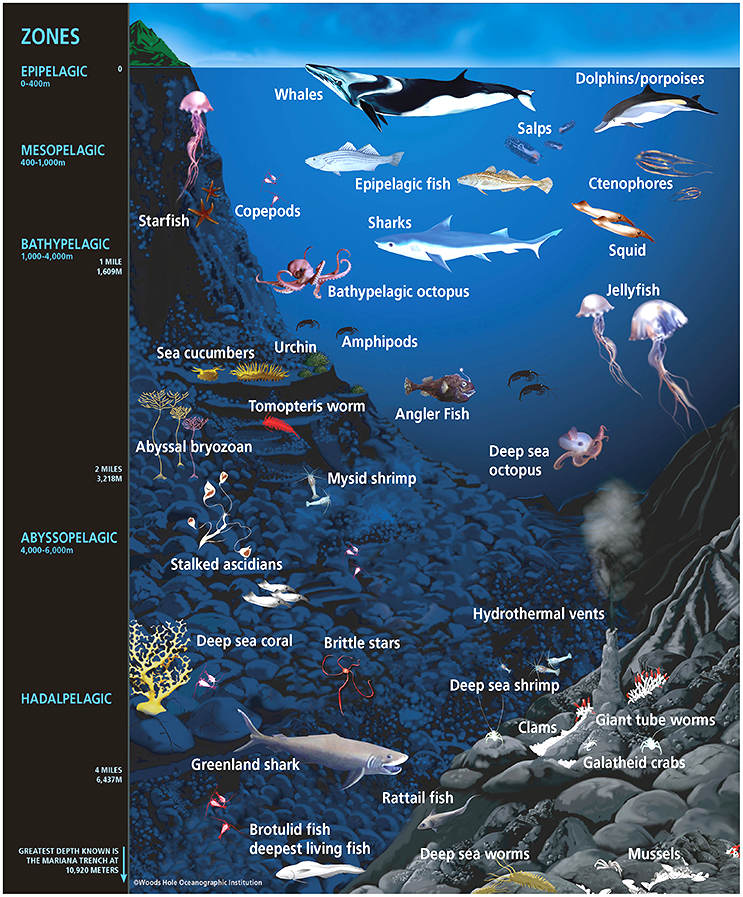
ONE
OCEAN DIVIDED INTO FIVE CONVENIENT SEGMENTS
While there is only one global ocean, the vast body of water that covers about 71 percent of the Earth is geographically divided into distinct named regions. The boundaries between these regions have evolved over time for a variety of historical, cultural, geographical, and scientific reasons.
Historically, there are four named oceans: the Atlantic, Pacific, Indian, and Arctic. However, most countries - including the United States - now recognize the Southern
(Antarctic) as the fifth ocean. The Pacific, Atlantic, and Indian are the most commonly known.
The Southern Ocean is the 'newest' named ocean. It is recognized by the U.S. Board on Geographic Names as the body of water extending from the coast of Antarctica to the line of latitude at 60 degrees South. The boundaries of this ocean were proposed to the International Hydrographic Organization in 2000. However, not all countries agree on the proposed boundaries, so this has yet to be ratified by members of the IHO. The U.S. is a member of the IHO, represented by the NOS Office of Coast Survey.
The ocean contains 97% of Earth's water and is the primary component of the Earth's hydrosphere, thus the ocean is essential to life on Earth. The ocean influences climate and weather patterns, the carbon cycle, and the water cycle by acting as a huge heat reservoir.
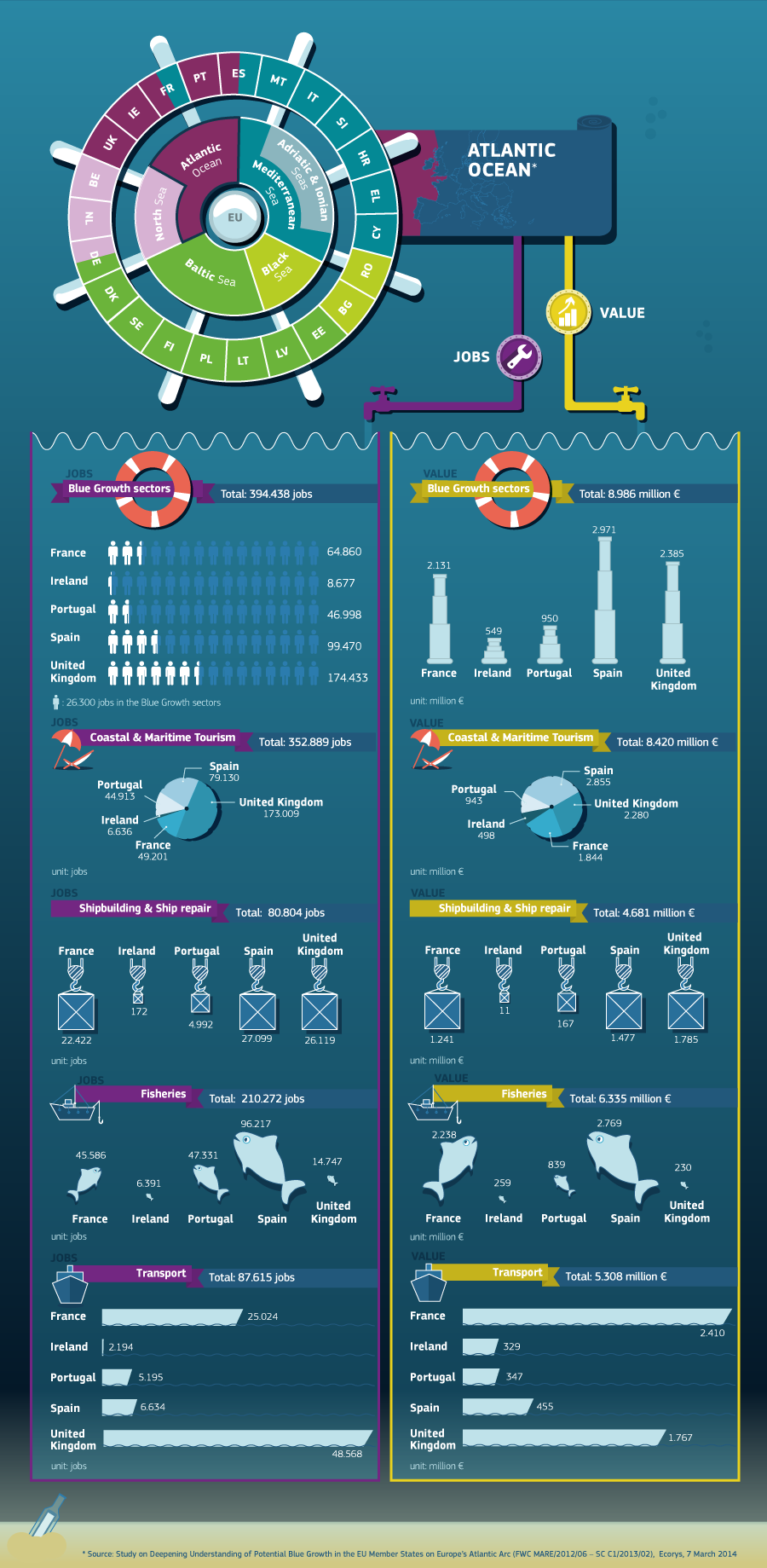
Oceanographers split the ocean into vertical and horizontal zones based on physical and biological conditions. The pelagic zone is the open ocean's water column from the surface to the ocean floor. The water column is further divided into zones based on depth and the amount of light present. The photic zone starts at the surface and is defined to be "the depth at which light intensity is only 1% of the surface value": 36 (approximately 200 m in the open ocean). This is the zone where photosynthesis can occur. In this process plants and microscopic algae (free floating
phytoplankton) use light, water, carbon dioxide, and nutrients to produce organic matter. As a result, the photic zone is the most biodiverse and the source of the food supply which sustains most of the ocean ecosystem. Ocean photosynthesis also produces half of the oxygen in the Earth's atmosphere. Light can only penetrate a few hundred more meters; the rest of the deeper ocean is cold and dark (these zones are called mesopelagic and aphotic zones). The continental shelf is where the ocean meets dry land. It is more shallow, with a depth of a few hundred meters or less. Human activity often has negative impacts on the ecosystems within the continental shelf.
Ocean temperatures depend on the amount of solar radiation reaching the ocean surface. In the tropics, surface temperatures can rise to over 30 °C (86 °F). Near the poles where sea ice forms, the temperature in equilibrium is about −2 °C (28 °F). In all parts of the ocean, deep ocean temperatures range between −2 °C (28 °F) and 5 °C (41 °F). Constant circulation of water in the ocean creates ocean currents. These directed movements of seawater are caused by forces operating on the water, such as temperature variations, atmospheric circulation (wind), the Coriolis effect and salinity changes. Tides create tidal currents, while wind and waves cause surface currents. The Gulf Stream, Kuroshio Current, Agulhas Current and
Antarctic Circumpolar Current are all major ocean currents. Currents transport massive amounts of water and heat around the world. By transporting these pollutants from the surface into the deep ocean, this circulation impacts global climate and the uptake and redistribution of pollutants such as carbon dioxide.
Ocean water contains a high concentration of dissolved gases, including oxygen, carbon dioxide and
nitrogen. This gas exchange occurs at the ocean's surface and solubility depends on the temperature and salinity of the
water.
Carbon dioxide concentration in the atmosphere rises due to
fossil fuel combustion, which causes higher levels in ocean water, resulting in ocean acidification. The ocean provides crucial environmental services to humankind, such as climate regulation. It also provides a means of trade and transport as well as access to
food and other resources. It is known to be the habitat of over 230,000 species, but may hold considerably more – perhaps over two million species. However, the ocean faces numerous human-caused environmental threats, such as marine pollution,
overfishing, and effects of
climate change on oceans such as ocean warming, ocean acidification and sea level rise. The continental shelf and coastal waters that are most affected by
human activity are particularly vulnerable.
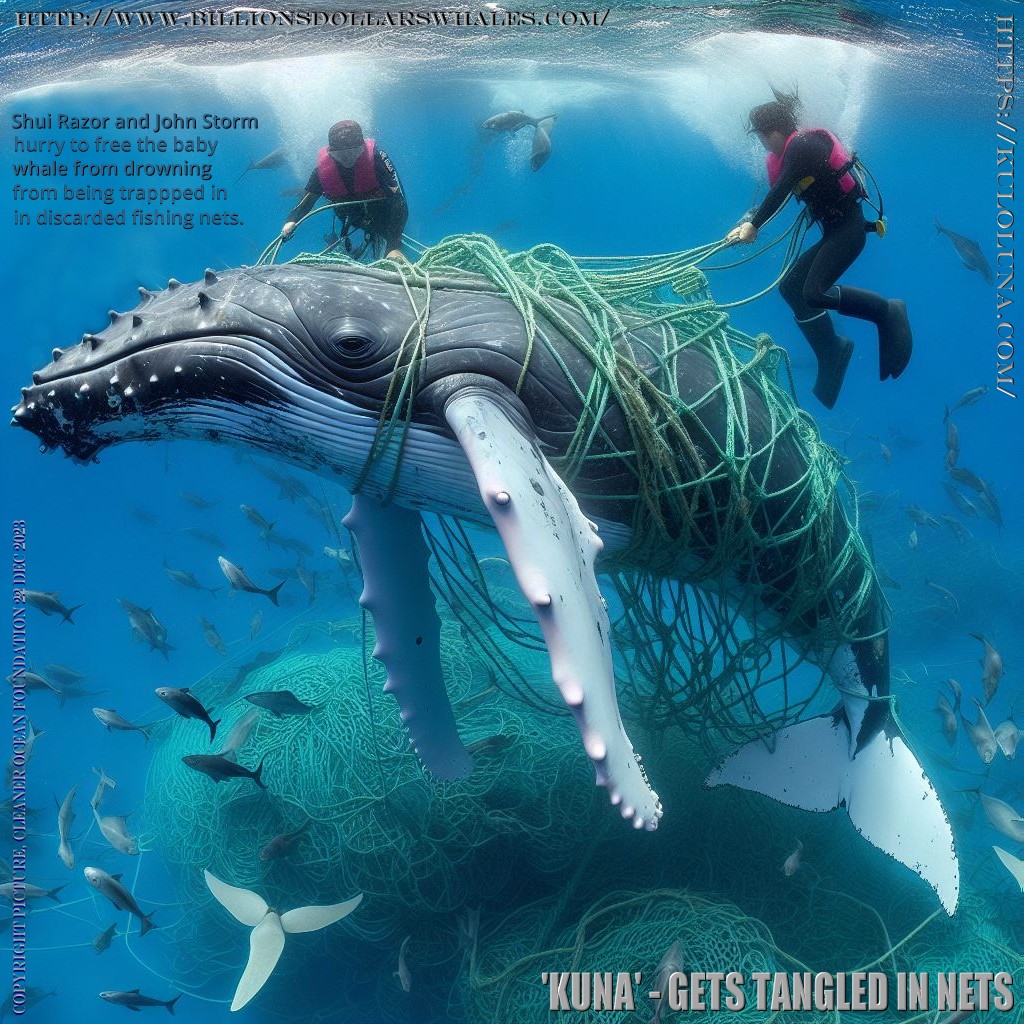
MARINE LIFE & HABITATS ON EARTH
Life within the ocean evolved 3 billion years prior to life on land. Both the depth and the distance from shore strongly influence the biodiversity of the plants and animals present in each region. The diversity of life in the ocean is immense, including:
- Animals: most animal phyla have species that inhabit the ocean, including many that are found only in marine environments such as sponges, Cnidaria (such as corals and jellyfish), comb jellies, Brachiopods, and Echinoderms (such as sea urchins and sea stars). Many other familiar animal groups primarily live in the ocean, including cephalopods (includes octopus and
squid), crustaceans (includes
lobsters,
crabs, and shrimp),
fish,
sharks,
cetaceans (includes
whales, dolphins, and porpoises). In addition, many land animals have adapted to living a major part of their life on the oceans. For instance, seabirds are a diverse group of birds that have adapted to a life mainly on the oceans. They feed on marine animals and spend most of their lifetime on water, many going on land only for breeding. Other birds that have adapted to oceans as their living space are penguins, seagulls and pelicans. Seven species of turtles, the sea turtles, also spend most of their time in the oceans.
- Plants: including sea grasses, or mangroves
- Algae: algae is a "catch-all" term to include many photosynthetic, single-celled eukaryotes, such as green
algae, diatoms, and dinoflagellates, but also multicellular algae, such as some red algae (including organisms like Pyropia, which is the source of the edible nori
seaweed), and brown algae (including organisms like
kelp).
- Bacteria: ubiquitous single-celled prokaryotes found throughout the world
- Archaea: prokaryotes distinct from bacteria, that inhabit many environments of the ocean, as well as many extreme environments
- Fungi: many marine fungi with diverse roles are found in oceanic environments

BLUEBIRD
MARINE - Oil
and plastic
pollution totaling some 270,000 tons of waste in five major ocean
gyres, is killing life in the oceans and poisoning our food chain. Dolphins,
Seals and Turtles that have been trapped by plastic bags, nets and the
like are common sights. These animals cannot clean the oceans up
themselves. They need the help of the humans that caused the problem,
turning their
habitat into a convenient 'out of sight' rubbish dump. And guess what? As
yet, nobody is eager to pay to clean it up.
Marine life, sea life, or ocean life is the plants, animals, and other organisms that live in the salt water of seas or oceans, or the brackish water of coastal estuaries. At a fundamental level, marine life affects the nature of the planet. Marine organisms, mostly microorganisms, produce oxygen and sequester carbon. Marine life, in part, shape and protect shorelines, and some marine organisms even help create new land (e.g. coral building reefs).
Marine species range in size from the microscopic like phytoplankton, which can be as small as 0.02 micrometres, to huge cetaceans like the
blue whale – the largest known animal, reaching 33 m (108 ft) in length. Marine microorganisms, including protists and bacteria and their associated viruses, have been variously estimated as constituting about 70% or about 90% of the total marine biomass. Marine life is studied scientifically in both marine biology and in biological oceanography. The term marine comes from the Latin mare, meaning "sea" or "ocean".
A marine habitat is a habitat that supports marine life. Marine life depends in some way on the saltwater that is in the sea (the term marine comes from the Latin mare, meaning sea or ocean). A habitat is an ecological or environmental area inhabited by one or more living species. The marine environment supports many kinds of these habitats.
Marine ecosystems are the largest of Earth's aquatic ecosystems and exist in waters that have a high salt content. These systems contrast with freshwater ecosystems, which have a lower salt content. Marine waters cover more than 70% of the surface of the Earth and account for more than 97% of Earth's water supply and 90% of habitable space on Earth. Seawater has an average salinity of 35 parts per thousand of water. Actual salinity varies among different marine ecosystems. Marine ecosystems can be divided into many zones depending upon water depth and shoreline features. The oceanic zone is the vast open part of the ocean where animals such as whales, sharks, and tuna live. The benthic zone consists of substrates below water where many invertebrates live. The intertidal zone is the area between high and low tides. Other near-shore (neritic) zones can include mudflats, seagrass meadows, mangroves, rocky intertidal systems, salt marshes, coral reefs, lagoons. In the deep water, hydrothermal vents may occur where chemosynthetic sulfur bacteria form the base of the food web.
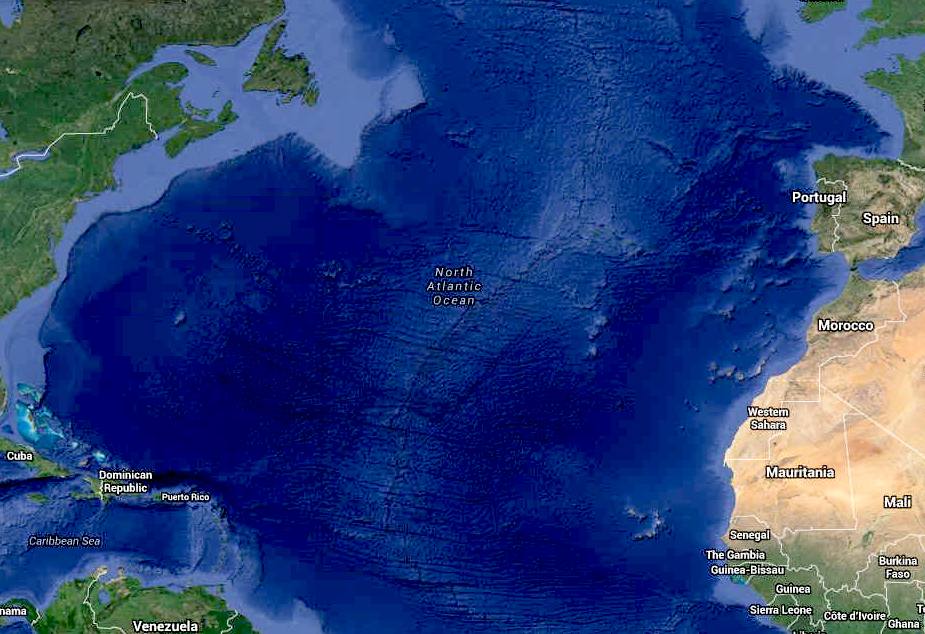
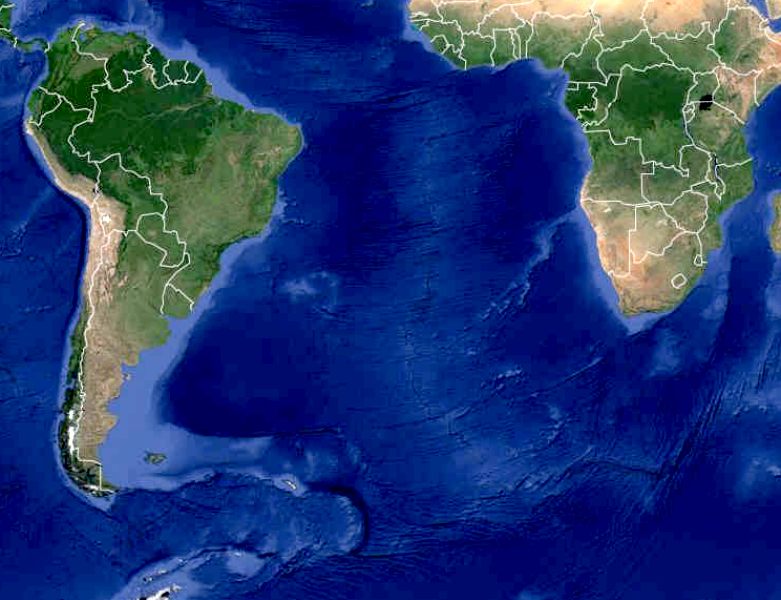
MAP -
North and South Atlantic Ocean

DEAD
ZONES - Fish and crabs cannot survive in oxygen depleted ocean zones.
WHAT IS A RIVER?
All over the world, rivers are valuable, often sacred, cultural and practical assets. They are a defining feature of human settlements, exploited for millennia as a source of drinking water, food, irrigation, waste disposal, power,
navigation, defence and even inspiration.
A river is a natural stream of water that flows in a channel with more or less defined banks. Rivers are a fundamental link in the hydrologic cycle, and they play a major role in shaping the surface features of the Earth. Even apparently arid desert regions are greatly influenced by river action when periodic floodwaters surge down usually dry watercourses. River flow is sustained by the difference between water input and output. Rivers are fed by overland runoff, groundwater seepage, and meltwater released along the edges of snowfields and glaciers. Direct precipitation contributes only very small amounts of water. Losses of river water result from percolation into porous and permeable rock, gravel, or sand; evaporation; and ultimately outflow into the ocean.
Rivers are important for many reasons. One of the most important things they do is carry large quantities of water from the land to the ocean. There, seawater constantly evaporates. The resulting water vapor forms clouds. Clouds carry moisture over land and release it as precipitation. This freshwater feeds rivers and smaller streams. The movement of water between land, ocean, and air is called the water cycle. The water cycle constantly replenishes Earth’s supply of fresh water, which is essential for almost all living things.

ANATOMY OF A RIVER
No two rivers are exactly alike. Yet all rivers have certain features in common and go through similar stages as they age.
The beginning of a river is called its source or headwaters. The source may be a melting glacier, such as the Gangotri Glacier, the source of the Ganges River in Asia. The source could be melting snow, such as the snows of the Andes, which feed the
Amazon River. A river’s source could be a lake with an
out-flowing stream, such as Lake Itasca in the U.S. state of Minnesota, the source of the Mississippi River. A spring bubbling out of the ground can also be the headwaters of a river. The source of the Danube River is a spring in the Black Forest of Germany.
From its source, a river flows downhill as a small stream. Precipitation and groundwater add to the river’s flow. It is also fed by other streams, called tributaries. For instance, the Amazon River receives water from more than 1,000 tributaries. Together, a river and its tributaries make up a river system. A river system is also called a drainage basin or watershed. A river’s watershed includes the river, all its tributaries, and any groundwater resources in the area.
The end of a river is its mouth. Here, the river empties into another body of
water - a larger river, a lake, or the ocean. Many of the largest rivers empty into the ocean.
The flowing water of a river has great power to carve and shape the landscape. Many landforms, like the Grand Canyon in the U.S. state of Arizona, were sculpted by rivers over time. This process is called weathering or erosion.
The energy of flowing river water comes from the force of gravity, which pulls the water downward. The steeper the slope of a river, the faster the river moves and the more energy it has.
The movement of water in a river is called a current. The current is usually strongest near the river’s source. Storms can also increase the current. A swift current can move even large boulders. These break apart, and the pieces that are carried in the moving water scrape and dig into the river bottom, or bed.
Little by little, a river tears away rocks and soil along its bed, and carries them downstream. The river carves a narrow, V-shaped valley. Rapids and waterfalls are common to rivers, particularly near their sources.
Eventually, the river flows to lower land. As the slope of its course flattens, the river cuts less deeply into its bed. Instead, it begins to wind from side to side in looping bends called meanders. This action widens the river valley.
At the same time, the river begins to leave behind some of the rocks, sand, and other solid material it collected upstream. This material is called sediment. Once the sediment is deposited, it is called alluvium. Alluvium may contain a great deal of eroded topsoil from upstream and from the banks of its meanders. Because of this, a river deposits very fertile soil on its flood plain. A flood plain is the area next to the river that is subject to flooding.
The deepest part of a river bed is called a channel. The channel is usually located in the middle of a river. Here, the current is often strong. In large
rivers, ships travel in channels. Engineers may dredge, or dig, deeper channels so more water can flow through the river or the river can transport larger ships.
Near the end of its journey, the river slows and may appear to move sluggishly. It has less energy to cut into the land, and it can no longer carry a heavy load of sediment. Where the river meets the ocean or a lake, it may deposit so much sediment that new land, a delta, is formed.
Not all rivers have deltas. The Amazon does not have a true delta, for instance. The strength of the tides and currents of the Atlantic Ocean prevent the build-up of sediment. Deltas almost always have fertile soil. The
Nile Delta and the Ganges Delta are the chief agricultural areas for
Egypt and Bangladesh, for instance.
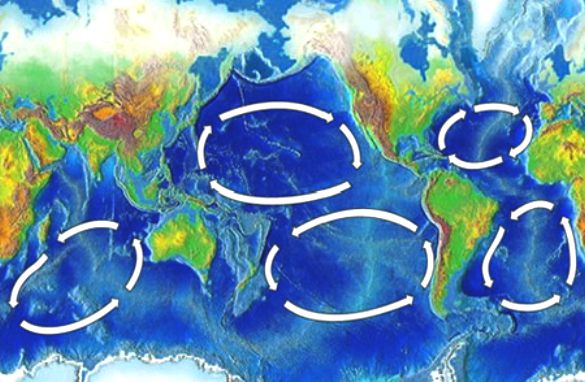
PLASTIC
ZONES - Along with the other three gyres, the north and south Atlantic
ocean gyres are additional regions where fish are not in healthy
waters.
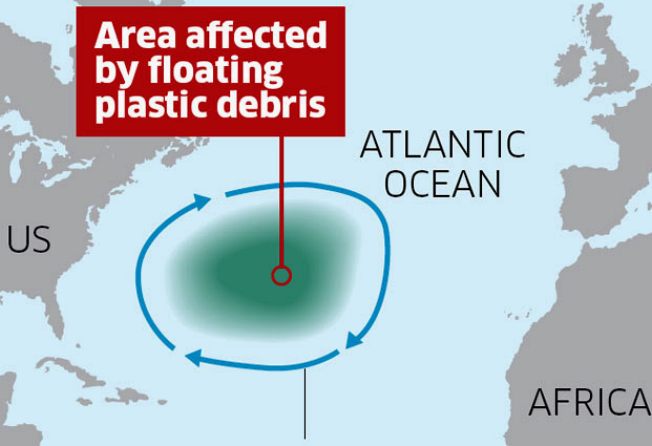
MARINE
POLLUTION
Marine pollution occurs when substances used or spread by humans, such as industrial,
agricultural and residential waste, particles, noise, excess
carbon dioxide or invasive organisms enter the ocean and cause harmful effects there. The majority of this waste (80%) comes from land-based activity, although marine transportation significantly contributes as well. It is a combination of chemicals and trash, most of which comes from land sources and is washed or blown into the ocean. This pollution results in damage to the environment, to the health of all organisms, and to economic structures worldwide. Since most inputs come from land, either via the rivers, sewage or the atmosphere, it means that continental shelves are more vulnerable to pollution.
Air pollution is also a contributing factor by carrying off iron, carbonic acid, nitrogen, silicon, sulfur, pesticides or dust particles into the ocean. The pollution often comes from nonpoint sources such as agricultural runoff, wind-blown debris, and dust. These nonpoint sources are largely due to runoff that enters the ocean through rivers, but wind-blown debris and dust can also play a role, as these pollutants can settle into waterways and oceans. Pathways of pollution include direct discharge, land runoff, ship pollution, bilge pollution, atmospheric pollution and, potentially, deep sea mining.
The types of marine pollution can be grouped as pollution from marine debris, plastic pollution, including microplastics, ocean acidification, nutrient pollution, toxins and underwater noise. Plastic pollution in the ocean is a type of marine pollution by plastics, ranging in size from large original material such as bottles and bags, down to microplastics formed from the fragmentation of plastic material. Marine debris is mainly discarded human rubbish which floats on, or is suspended in the ocean. Plastic pollution is harmful to marine life.

PLASTIC POLLUTION
Marine plastic pollution is a type of marine pollution by plastics, ranging in size from large original material such as bottles and bags, down to microplastics formed from the fragmentation of plastic material. Marine debris is mainly discarded human rubbish which floats on, or is suspended in the ocean. Eighty percent of marine debris is plastic.
Microplastics and nanoplastics result from the breakdown or photodegradation of plastic waste in surface waters, rivers or oceans. Recently, scientists have uncovered nanoplastics in heavy snow, more specifically about 3,000 tons that cover Switzerland yearly.
It is estimated that there is a stock of 86 million tons of plastic marine debris in the worldwide ocean as of the end of 2013, assuming that 1.4% of global plastics produced from 1950 to 2013 has entered the ocean and has accumulated there. Global consumption of plastics is estimated to be 300 million tonnes per year as of 2022, with around 8 million tonnes ending up in the oceans as macroplastics. Approximately 1.5 million tonnes of primary microplastics end up in the seas. Around 98% of this volume is created by land-based activities, with the remaining 2% being generated by sea-based activities. It is estimated that 19–23 million tonnes of plastic leaks into aquatic ecosystems annually. The 2017
United Nations Ocean Conference estimated that the oceans might contain more weight in plastics than fish by the year 2050.
CLIMATE CHANGE
There are many effects of climate change on oceans. One of the main ones is an increase in ocean temperatures. More frequent marine heatwaves are linked to this. The rising temperature contributes to a rise in sea levels. Other effects include ocean
acidification, sea ice decline, increased ocean stratification and reductions in oxygen levels. Changes to ocean currents including a weakening of the Atlantic meridional overturning circulation are another important effect. All these changes have knock-on effects which disturb marine ecosystems. The main cause of these changes is climate change due to human emissions of greenhouse gases. Carbon dioxide and methane are examples of
greenhouse
gases. This leads to ocean warming, because the ocean takes up most of the additional heat in the climate system. The ocean absorbs some of the extra carbon dioxide in the atmosphere. This causes the pH value of the ocean to drop. Scientists estimate that the ocean absorbs about 25% of all human-caused CO2 emissions.
Ocean temperature stratification is the difference in temperature between the various layers of the ocean. It increases as the ocean surface warms due to rising air temperatures. The decline in mixing of the ocean layers stabilizes warm water near the surface. It also reduces cold, deep water circulation. The reduced vertical mixing makes it harder for the ocean to absorb heat. So a larger share of future warming goes into the atmosphere and land. One result is an increase in the amount of energy available for tropical cyclones and other storms. Another result is a decrease in nutrients for fish in the upper ocean layers. These changes also reduce the ocean's capacity to store carbon. At the same time, contrasts in salinity are increasing. Salty areas are becoming saltier and fresher areas less salty.
Warmer water cannot contain the same amount of oxygen as cold water. As a result, oxygen from the oceans moves to the atmosphere. Increased thermal stratification may reduce the supply of oxygen from surface waters to deeper waters. This lowers the water's oxygen content even more. The ocean has already lost oxygen throughout its water column. Oxygen minimum zones are expanding worldwide.
These changes harm marine ecosystems, which can accelerate species extinctions or cause
population explosions, altering species distribution. This also affects coastal fishing and tourism. Rising water temperatures will also harm various oceanic ecosystems, such as coral reefs. The direct effect is coral bleaching on these reefs, which are sensitive to even minor temperature changes, so a small increase in temperature could have a significant impact in these environments. Ocean acidification and temperature rise will also affect the productivity and distribution of species within the ocean, threatening fisheries and upsetting marine ecosystems. Loss of sea ice habitats due to warming will severely impact the many polar species that rely on it. The interactions between many of these climate change factors increase pressures on the climate system and ocean ecosystems.

TWELVE
MOST BEAUTIFUL & FAMOUS EUROPEAN
RIVERS
Blue
Danube - Black Forest to Black Sea
Don - Russian
Douro -
Spain & Portugal
Elbe -
Czech Republic & Germany
Loire -
France
Maine - France
Moselle -
Germany
Po -
Italy
Rhine -
Germany
Rhône -
Swiss Alps & France
Seine -
Dijon France to English
Channel
Tiber -
Italy
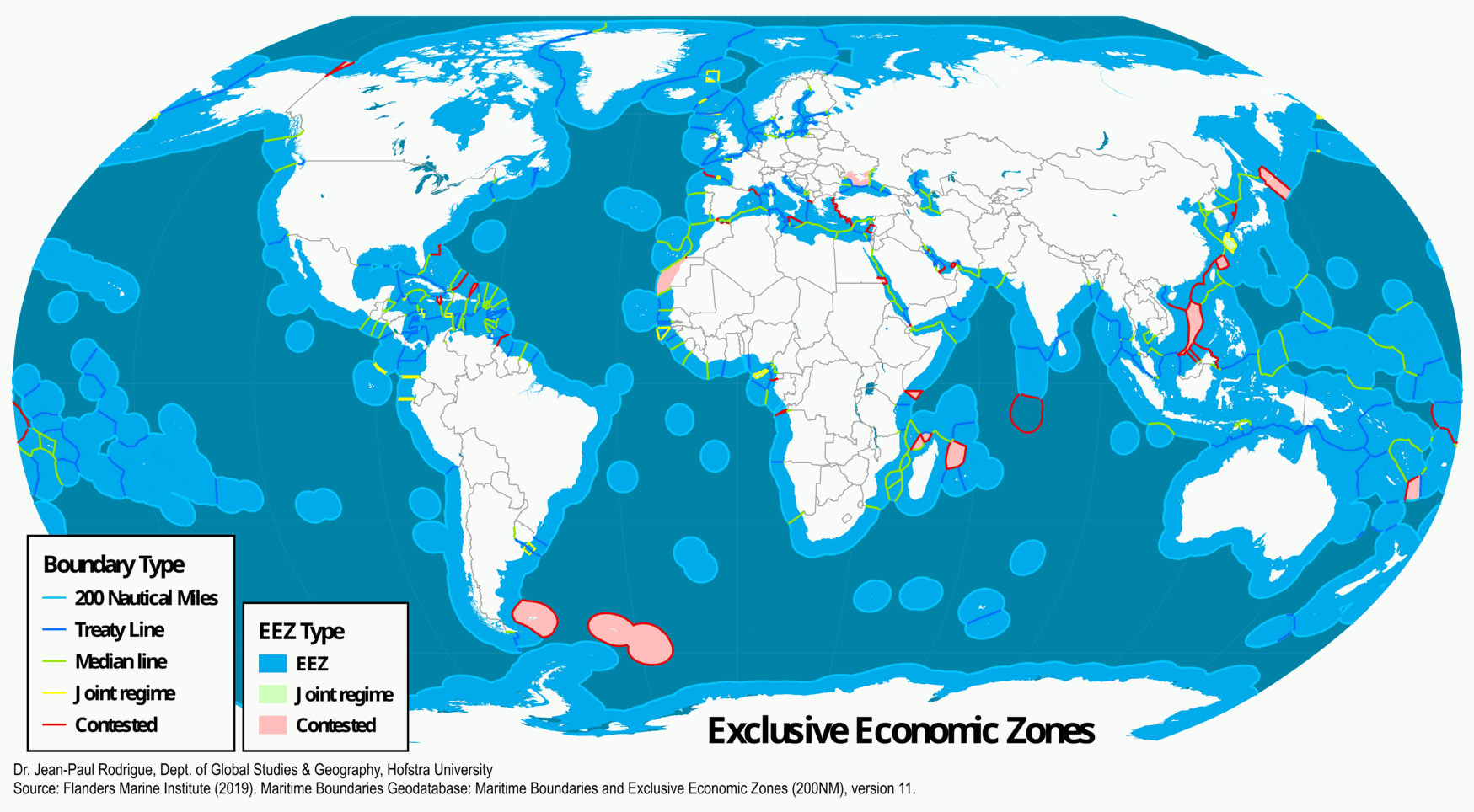
An exclusive economic zone (EEZ), as prescribed by the 1982 United Nations Convention on the Law of the Sea, is an area of the sea in which a sovereign state has exclusive rights regarding the exploration and use of marine resources, including energy production from water and wind. EEZ does not define the ownership of any maritime features (islands, rocks and low-tide elevations) within the EEZ.
It stretches from the outer limit of the territorial sea (22.224 kilometres or 12 nmi from the baseline) out 370.4 kilometres (or 200 nautical miles) from the coast of the state in question. It is also referred to as a maritime continental margin and, in colloquial usage, may include the continental shelf. The term does not include either the territorial sea or the continental shelf beyond the 200 nautical mile limit. The difference between the territorial sea and the exclusive economic zone is that the first confers full sovereignty over the waters, whereas the second is merely a "sovereign right" which refers to the coastal state's rights below the surface of the sea. The surface waters are international waters.
Most of the plastic floating in the upper 3
meters of the ocean appears to be polyethylene or
polypropylene, which are less dense than seawater and float near to the surface. However, other kinds of denser plastic debris may have sunk to the bottom of the ocean where it has disappeared from view.
The study, published in the journal Science, found that the concentration of plastic particles caught in the nets since the survey began in 1986 has remained remarkably constant – but Dr Lavender Law emphasised that this did not mean the problem was manageable. "It does seem constant but we have to be careful about the interpretation that it is not getting worse, because what we are measuring is plastic larger than a third of a millimetre in size floating at the surface," she said.
"One explanation is that the pieces are becoming small enough to pass straight through the net. The plastic may still be floating at the ocean surface – it's just that we are not collecting it once it's smaller than a particular size.
"Another explanation is that we've found evidence that biological growth on pieces of plastic actually makes them denser and it's possible that, over time, if there is enough biological growth they may become dense enough to sink from the surface, where we wouldn't collect it," she explained.
Small fragments of plastic could pose an even greater menace to marine life than the larger fragments that become entangled with animals such as
albatrosses and
turtles, she said. "We know that smaller pieces of plastic are eaten and it's unclear what happens to that plastic then. But clearly biological organisms were not designed to eat plastic," she said.
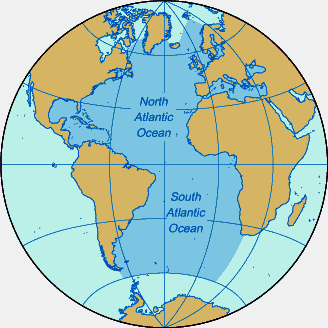

The
Atlantic Oceans world location map
ACIDIFICATION
- ADRIATIC -
AEGEAN
- ARCTIC
- ATLANTIC
BALTIC
- BAY BENGAL - BAY
BISCAY - BERING
- BLACK
CARIBBEAN - CORAL
- EAST CHINA - ENGLISH
CH - FINLAND
GOC
- GULF GUINEA - GULF
MEXICO - GULF THAILAND - GULF
TONKIN
INDIAN -
IONIAN
- IOC
- IRISH
- MEDITERRANEAN - NORTH
SEA
PACIFIC - PERSIAN
GULF
- SEA JAPAN
- STH
CHINA - PLASTIC
OCEANS - RED
SEA
SARGASSO
- SEA
LEVEL RISE - SOUTHERN
OCEAN - TYRRHENIAN
AMAZON
- BURIGANGA - CITARUM -
CONGO -
CUYAHOGA
-
GANGES -
IRTYSH
-
JORDAN -
LENA -
MANTANZA-RIACHUELO - MARILAO
- MEKONG -
MISSISSIPPI -
NIGER -
NILE -
PARANA -
PASIG -
SARNO - THAMES
- YAMUNA -
YANGTZE -
YELLOW -
ZHUJIANG

SEAVOLUTION
- SeaVax was an amazing machine, designed to filter seawater of pollution,
adapt-ably. To cope with visible floating garbage, and the plastic soup
that floats invisibly, on or just under the surface of the waves. Crowd
funding from Avaaz, topped up the donations of volunteers and director
input from Bluebird Marine Systems Ltd. Cleaner Ocean Foundation took over
from BMS, inputting additional funding until it became obvious they were
flogging a dead horse. Pulling out to remain solvent.
Development
began at a brisk pace in 2016, stalled past 2021, when all avenues of funding
dried up. The then team having made three comprehensive applications for Horizon
2020 funding, and lobbied the G7, even including the United Nations. The revolutionary energy harvesting system was proven at 1:20
scale, in basic form without the robotic particle identification and separation
elements essential to avoid picking up flora
and fauna, along with micro and macro plastics.
The proposed SeaVax vessel
was designed by visionaries to suck up to 50 tons of micro and macro waste a
day, operating in fleets autonomously, so steadily cleaning the massive swirling gyres of
toxins. It could even harvest ghost fishing
nets. Tragically, the world lost the opportunity to fuel the
enthusiasm of the innovators past 2017 into 2021. When the goodwill
fizzled, out of necessity to survive. Eat, or starve.
The Foundation are
hopeful that eventually the pollution problem will be recognised for the
pariah that it is, when another equally industrious group, just as
innovative as the first might take up the gauntlet. The
original dream team were forced to resume paying mortgages and the like,
having given 5 years of their lives as volunteers, and lived to tell the
tale. Well done and big
thanks to all who helped prove the innovation from twenty-sixteen.
Please use our A-Z
to navigate this
site where page links may lead to other sites, or see
HOME
|














